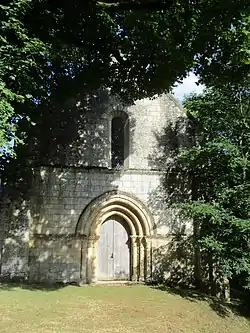Plaincourault Chapel
Plaincourault Chapel is a 12th-century chapel of the Knights Hospitaller in Mérigny, Indre, France.[1] The structure, which is located next to the Château de Plaincourault, suffered extensive damage during the French Revolution and was abandoned in 1793. It was declared a historical monument in 1944, but was not restored until the Parc naturel régional de la Brenne took ownership of the property in 1994.[2] The chapel is famous for its unusual Romanesque art, particularly its Christian frescoes.[3][4] As part of the Château de Plaincourault complex, it is designated by the French Ministry of Culture as a monument historique.[5]
| External image | |
|---|---|

Facade of the Romanesque chapel of Plaincourault, facing west.
References
- Gaudon, Constantin (1868). Histoire du Blanc et de ses environs. Ampetit. ISBN 1295095572. pp. 290-293.
- La chapelle de Plaincourault. La commune de Mérigny. Archived on 2008-09-13.
- Ramsbottom, J. (1925). Edible and Poisonous Fungi. Proc R Soc Med. 18 (Sect Trop Dis Parasitol): 13–26. PMC 2202295
- Ruck, Carl A.P.; Jose Alfredo Gonzalez Celdran (2007). Melusina of Plaincourault. The Hidden World: Survival of Pagan Shamanic Themes in European Fairytales. Carolina Academic Press. ISBN 1-59460-144-5. pp. 309-380.
- Indexed in the Base Mérimée, a database of architectural heritage maintained by the French Ministry of Culture, under the reference PA00097393.
Further reading
- Boudier, Jean Louis Émile (1911). La fresque de Plaincourault (Indre). Bulletin de la Société Mycologique de France 27: 31 - 33.
- Samorini, Giorgio (1997). The 'Mushroom-Tree' of Plaincourault, Eleusis: Journal of Psychoactive Plants and Compounds 8: 29–37.
External links
- Official site (French)
This article is issued from Wikipedia. The text is licensed under Creative Commons - Attribution - Sharealike. Additional terms may apply for the media files.